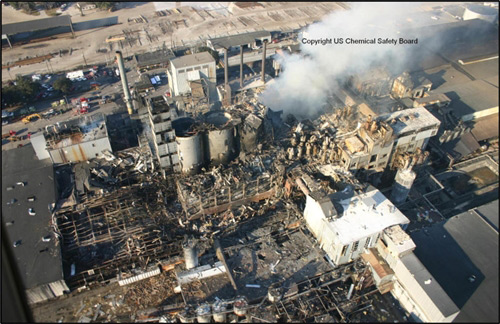Explaining the phenomenon of pigment explosion in Taiwan water park
When flammable powdered material is dense in air exposed to heat, it will ignite at an extremely fast rate, releasing large amounts of heat.
How does exploding pigments in Taiwan water park happen?
This is said to be the cause of the dust explosion disaster at a water park in Taiwan last weekend, causing hundreds of people to be injured.

Imperial Sugar Sugar Factory after the dust explosion in 2008. (Photo: US Chemical Safety Board).
The dust cloud of any material that can burn will explode if the dust concentration concentrates in the air that falls into the explosion threshold and has the source of the heat needed for it, according to Dust Explosion Info. We can prevent the explosion from happening by ensuring the exclusion of one or the best is both conditions.
When a solid mass of combustible material is heated, it will slowly burn due to the limited amount of surface area exposed to oxygen in the air. The energy is released slowly and harmlessly because it dissipates almost immediately after being released. However, the results will be completely different if the material is crushed into fine powder and mixed with air in the form of dust.
For example, a sphere weighing 1 kg made of material with a density of 1 g / cm3 will have a diameter of about 12.4 cm with a total surface area of about 482 cm2 (0.0482 m2). If crushed into particles with a diameter of 50µm, with wheat flour, the total area of the sphere is up to 120 m2.
Under this condition, the surface area exposed to oxygen is very large. If the ignition is present, the entire cloud of dust will ignite with lightning speed. Energy will come out unexpectedly with a large amount of heat.
This phenomenon also occurs with conventional materials that are non-flammable, such as aluminum, or flame retardant, like wood. If crushed to the appropriate size, they can create a large explosion requiring only a small spark.
The heat generated increases the pressure on the tool walls or the walls of the dusty room. The pressure is enough to destroy buildings and factories, causing casualties. The pressure also creates more dust from the equipment or the inside of the building, causing the second explosion.
However, not all dust clouds explode when there are two conditions mentioned above.Their densities must be within a certain threshold. Clouds and dust will not explode if the thickness is lower than or exceeds this threshold.
Scientists have identified the explosive threshold of dust clouds generated from different materials. They range from 10 g / m3 to 500 g / m3. The lower threshold of most flammable dust is 30 g / m3. The threshold is rarely used in practice, so data are rarely available.
Dust explosion is the cause of many disasters in the industry. On February 7, 2008, a massive explosion took place at the Imperial Sugar Sugar Factory in Port Wenworth, Georgia, USA, causing 14 deaths and 38 injuries.
The first blast came from a conveyor belt running below the road towers, adding to the amount of road dust coming from the road on the floor and the upper floors. The second incident appeared shortly after. Pressure caused damage to the concrete floor, collapsing walls.
On June 27, the unit held a Color Play Asia party at the Formosa Fun Coast water park, belonging to New Taipei, the most populous city in Taiwan, spraying a color powder to create a stage effect on the dancing crowd. in great music. The cloud of powder ignited and exploded shortly afterwards, injuring 498 people, according to the latest statistics. Among them, 202 are critical and this is the " worst disaster in New Taipei" .
- 8 most spectacular water parks in the world
- Mutant pig lion in HCMC
- Sea water threatens Taiwan
- Why do people have two different eye colors?
- Why is hot water freezing faster than cold water?
- Ho Chi Minh City is about to have Science Park more than VND 4,260 billion
- Explaining the phenomenon of foaming sand like boiling water
- Singapore inaugurated the first water park
- Video: Record rainbow for nearly 9 hours in Taiwan, China
- Create supernova explosions in the laboratory
- The magnitude 6.3 earthquake in Taiwan
- why are the forgs is green?
 'Fine laughs' - Scary and painful torture in ancient times
'Fine laughs' - Scary and painful torture in ancient times The sequence of numbers 142857 of the Egyptian pyramids is known as the strangest number in the world - Why?
The sequence of numbers 142857 of the Egyptian pyramids is known as the strangest number in the world - Why? History of the iron
History of the iron What is alum?
What is alum?